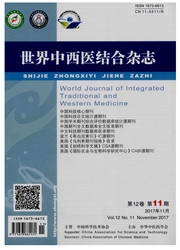

 中文摘要:
中文摘要:
目的通过文献分析探讨白癜风中医辨证论治规律。方法选取1994~2010年中国期刊全文数据库(CNKI)收录的中医诊治白癜风含证型或方药的文献,对所选文献中的证型、方剂和药物进行标准化整理,通过频度分析总结证型、方剂和药物特点,统计被文献引用频次和频率,并进行归类分析。结果白癜风常见证型有:肝肾阴虚17.02%、瘀血阻络10.63%、肝郁气滞10.63%、气血不和8.51%、脾气虚弱6.38%、阴虚内热4.26%、血热风热4.26%、血虚风燥4.26%、寒湿阻络4.26%、气虚血瘀4.26%。证候病位及所占百分比分别为肝46.88%、肾34.38%、脾18.74%。证候虚实中虚证占45.28%、实证占54.72%。成方有23个,其中二至丸、通窍活血汤、玉屏风散、补阳还五汤汤占48%。用药共196种,频次为1046。按功效归分为42类,进一步合并为20大类:补虚药排第一位,活血化瘀药次之,再次为解表药,它们共占所有用药的63%。结论中医诊治白癜风证型特点和方药规律的分析可为目前白癜风的辨证论治提供参考依据。对白癜风治疗要从多方面进行辨证,注意调节情志及扶助正气。
 英文摘要:
英文摘要:
Objective To explore the law of the pattern/syndrome differentiation and treatment de termination of Chinese medicine in the treatment of leucoderma through the literature analysis. Methods The literatures were collected in terms of the pattern/syndrome, herbal formula or medicine involved in the treatment of leucoderma with Chinese medicine recorded in CNKI from 1994 to 2012. The relevant patterns/ syndromes, herbal formulas and medicines in the literatures were collected in standardization. By the frequen cy analysis,the characteristics of the patterns/syndromes,herbal formulas and medicines were summarized. The quoted frequency in the literatures was analyzed in statistics for classification. Results The common patterns/syndromes of leucoderma were 17.02% of liver and kidney yin deficiency, 10.63% of blood stagna tion in collaterals, 10.63% of liver qi stagnation, 8.51% of qi and blood disharmony,6.38% of spleen qi deficiency,4.26% of yin deficiency and internal heat,4.26% of blood heat and wind heat,4.26% of blood deficiency and wind dryness,4.26% of wind damp blockage in collaterals and 4.26% of qi deficiency and blood stagnation. Concerning the deficiency or excess pattern/syndrome, the deficiency pattern/syndrome ac counted for 45.28% and the excess pattern/syndrome for 54.72%. Totally,23 herbal formulas were collect ed. Of them, er zhi wan, tongqiao huoxue tang, yupingfeng san, buyang huanwu tang accounted for 48 %. Total ly ,there were 196 medicines and the quoted frequency of them was 1046. Concerning to the efficacy ,42 cate gories were collected and they were further classified into 20 major groups. Of them, the medicines for tonic function in the deficiency pattern/syndrome were in the top 1 of the medication frequency, the medicines for activating blood circulation and removing stasis were in the top 2, and the medicines for eliminating the exte rior were in the top 3. They accounted for 63% of the total medication frequency. Conclusion The analysison the law of the characteristics of patterns/syndr
 同期刊论文项目
同期刊论文项目
 同项目期刊论文
同项目期刊论文
 期刊信息
期刊信息
